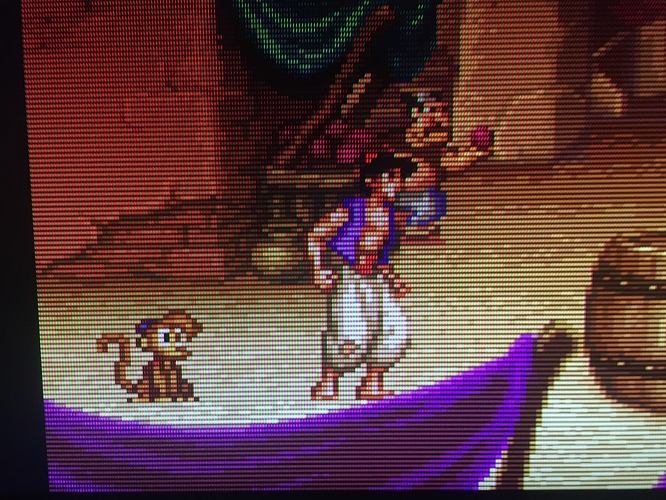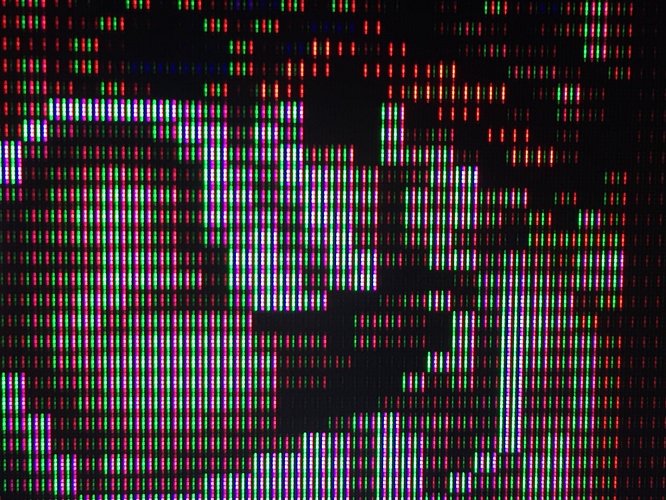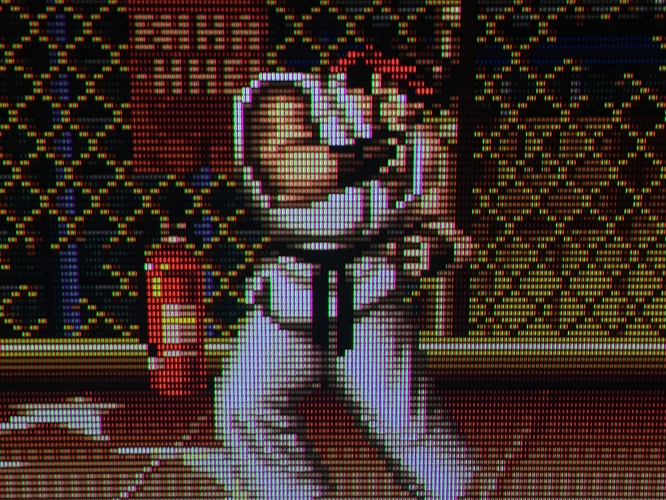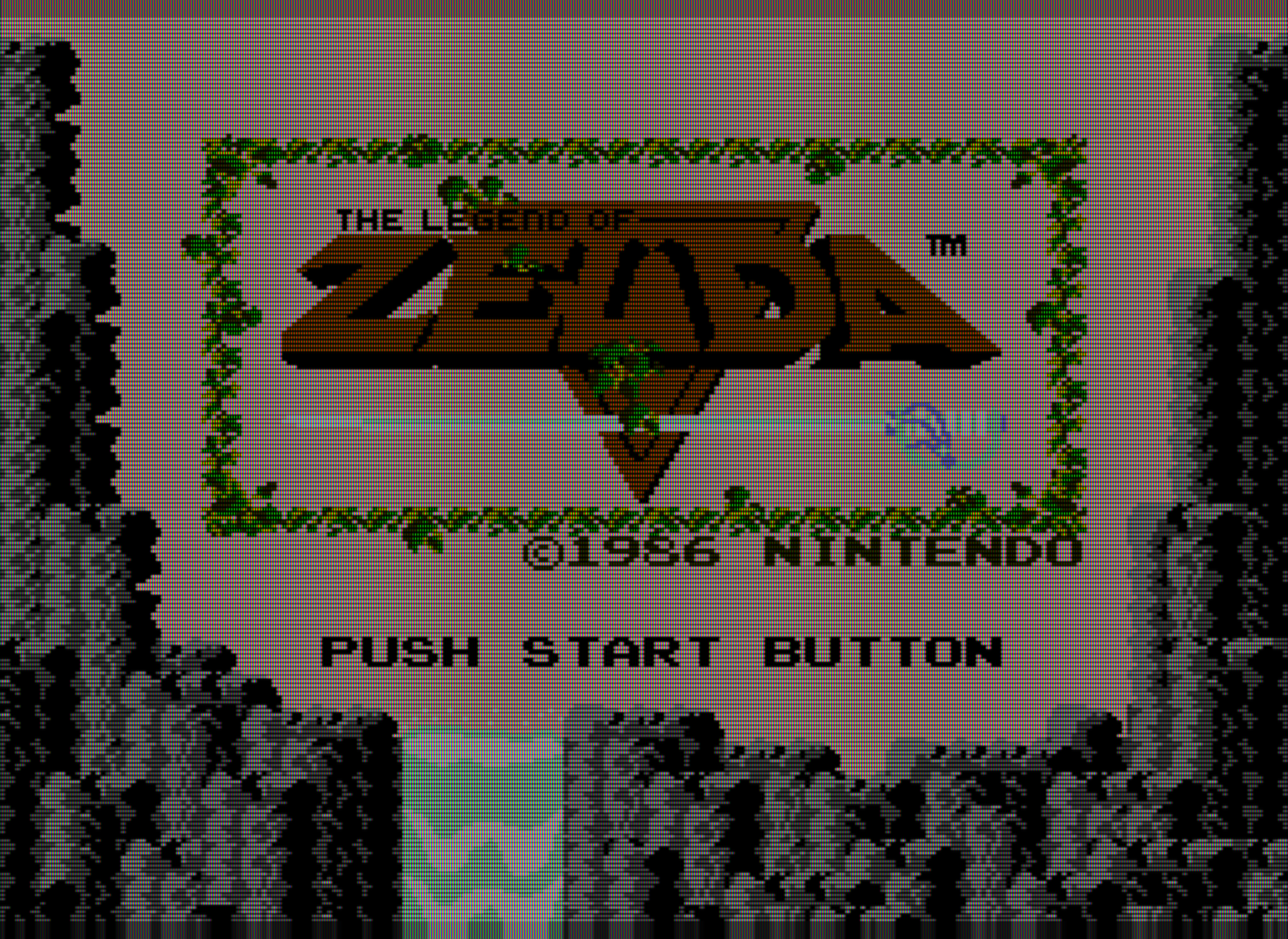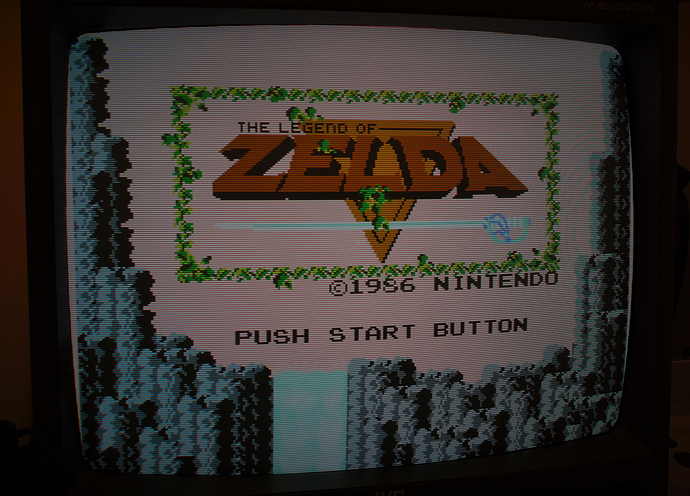Yeah, it’s very difficult to get a photo that’s both in focus and bright enough; all my photos come out either blurry and bright or in-focus and too dark. I made several attempts this morning to get some shots of Super Metroid, which has a challenging color palette. None of my photos were satisfactory. 
Some updates to my shader settings. I’ve found that a very slight amount of blur more accurately captures the transitions from light to dark pixels on a CRT than pure nearest neighbor filtering. The problem is that bilinear filter and most blurs are too heavy handed, excessively smearing the edges between light and dark colors, which destroys the contrast around highlights and makes the image somewhat flat and dull (not to mention the horrible effect it has on scanlines).
With Zfast CRT we can add a very slight amount of horizontal blur; this makes the transitions less harsh and closer to how they appear on a CRT without ruining the highlights and excessively blurring the image.
For gamma correction, I’ve also added the “image-adjustment” shader.
EDIT: changed x-axis blur from 0.10 to 0.00, updated screenshot.
BLURSCALEX* = “0.000000”
*A value of 0.20 clearly results in too much blur IMO. The shot below is using a setting of 0.00, which is still softer than the CRT. Ultimately, this will vary depending on the display used, viewing distance, and individual preference.
BRIGHTBOOST = “1.100000”
Upped bright boost a bit; contrast still looks good on my display.
HILUMSCAN = “8.000000”
ia_monitor_gamma = “2.200000”
ia_target_gamma = “2.400000”
LOWLUMSCAN = “9.000000”
MASK_DARK = “0.000000”
MASK_FADE = “0.700000”
maskDark = “0.100000”
Raised maskdark and mask fade a bit. I’m still measuring around 185 cd/m2 peak brightness on my display with the backlight at 100%. Since different displays have different max brightness levels, these settings need to be tailored to the individual display being used.
maskLight = “1.500000”
shadowMask = “2.000000”
shader filter set to “linear”
The first shot below is Retroarch with my new settings, the second shot is of an actual CRT hooked up to an RGB modded NES. The CRT is using a shadowmask, while the shader is emulating an aperture grille. As per usual, the backlight will need to be cranked up when viewing the shader with these settings.
I’m currently using a shader set up based off the preset you use, except I’ve swapped the image-adjustment.glsl with ntsc-colors.glsl. For reasons…
I’ll try and get some photos soon.
Hi, your shader is made for a 1080p or 4k display? Could you do an equivalence for games that have a native 480p resolution (like dreamcast, ps2, etc) ? Thank you.
These settings are for 1080p and work best at a 6x5 integer scale. If the horizontal scale isn’t a multiple of 3 you get color bleed from the mask. You can still use this with a 4K display but it will probably need some tweaking.
I’m not quite sure what you’re going for-
480p doesn’t display scanlines. You can disable the scanlines and keep everything else the same by altering the following settings:
HILUMSCAN = “0.000000”
LOWLUMSCAN = “0.000000”
You’ll also need to adjust the maskdark, masklight, mask_fade, and brightboost parameters to get the mask as dark as possible while still maintaining an adequate level of brightness on your display. Since different displays have different max brightness levels, I can’t really help you with that. I would use a light meter and try to maintain at least 175 cd/m2 brightness when displaying a white screen with the shader applied. Fudoh’s 240p test suite has a white screen test pattern you can use for this. If you don’t have a light meter available, there are smart phone apps that can get the job done.
I didn’t understand. For example, GameCube doesn’t display scanlines on a CRT TV?
That’s correct.
Only those systems which output at “240p” will have scanlines on a CRT.
“Scanlines” colloquially refers to the horizontal black gaps between visible lines when a CRT is displaying 240p.
With 480i, you can sometimes see moving horizontal lines on a CRT, but that’s not the same thing.
For GameCube and Dreamcast I apply the crt-hyllian-3d shader, so I can see the scanlines, unlike the crt-geom in which I can see only with the game paused. So it’s totally fake what hyllian-3d simulate?
Please, read:

Yeah, you can do a lot of weird stuff with shaders. CRT shaders are mostly designed with displaying 240p content in mind. If you want a more realistic 480p/480i look with shaders, almost all of them have parameters for adjusting the scanlines that allow you to disable them.
What shader do you recommend for 480p/480i?
Thanks.
For 480i/480p content, I would suggest zfast_CRT+dotmask, and disable the scanlines by making the following changes to the parameters:
HILUMSCAN = “0.000000”
LOWLUMSCAN = “0.000000”
For the other settings, see post 93 and post 96 in this thread.
You’ll have to adjust mask dark, mask light, bright boost and mask fade. For optimal results, you’ll need something like Fudoh’s 240p test suite and a light meter (or smartphone with a light meter app).
Here’s zfast_CRT+dotmask:
/*
zfast_crt_standard - A simple, fast CRT shader.
Copyright (C) 2017 Greg Hogan (SoltanGris42)
This program is free software; you can redistribute it and/or modify it
under the terms of the GNU General Public License as published by the Free
Software Foundation; either version 2 of the License, or (at your option)
any later version.
Notes: This shader does scaling with a weighted linear filter for adjustable
sharpness on the x and y axes based on the algorithm by Inigo Quilez here:
http://http://www.iquilezles.org/www/articles/texture/texture.htm
but modified to be somewhat sharper. Then a scanline effect that varies
based on pixel brighness is applied along with a monochrome aperture mask.
This shader runs at 60fps on the Raspberry Pi 3 hardware at 2mpix/s
resolutions (1920x1080 or 1600x1200).
*/
//For testing compilation
//#define FRAGMENT
//#define VERTEX
//This can't be an option without slowing the shader down
//Comment this out for a coarser 3 pixel mask...which is currently broken
//on SNES Classic Edition due to Mali 400 gpu precision
//#define FINEMASK
//Some drivers don't return black with texture coordinates out of bounds
//SNES Classic is too slow to black these areas out when using fullscreen
//overlays. But you can uncomment the below to black them out if necessary
//#define BLACK_OUT_BORDER
// Parameter lines go here:
#pragma parameter BLURSCALEX "Blur Amount X-Axis" 0.30 0.0 1.0 0.05
#pragma parameter LOWLUMSCAN "Scanline Darkness - Low" 6.0 0.0 10.0 0.5
#pragma parameter HILUMSCAN "Scanline Darkness - High" 8.0 0.0 50.0 1.0
#pragma parameter BRIGHTBOOST "Dark Pixel Brightness Boost" 1.25 0.5 1.5 0.05
#pragma parameter MASK_DARK "Mask Effect Amount" 0.0 0.0 1.0 0.05
#pragma parameter MASK_FADE "Mask/Scanline Fade" 0.8 0.0 1.0 0.05
#pragma parameter shadowMask "Mask Style" 3.0 0.0 4.0 1.0
#pragma parameter DOTMASK_STRENGTH "CGWG Dot Mask Strength" 0.3 0.0 1.0 0.01
#pragma parameter maskDark "Lottes maskDark" 0.5 0.0 2.0 0.1
#pragma parameter maskLight "Lottes maskLight" 1.5 0.0 2.0 0.1
#if defined(VERTEX)
#if __VERSION__ >= 130
#define COMPAT_VARYING out
#define COMPAT_ATTRIBUTE in
#define COMPAT_TEXTURE texture
#else
#define COMPAT_VARYING varying
#define COMPAT_ATTRIBUTE attribute
#define COMPAT_TEXTURE texture2D
#endif
#ifdef GL_ES
#define COMPAT_PRECISION mediump
#else
#define COMPAT_PRECISION
#endif
COMPAT_ATTRIBUTE vec4 VertexCoord;
COMPAT_ATTRIBUTE vec4 COLOR;
COMPAT_ATTRIBUTE vec4 TexCoord;
COMPAT_VARYING vec4 COL0;
COMPAT_VARYING vec4 TEX0;
COMPAT_VARYING float maskFade;
COMPAT_VARYING vec2 invDims;
vec4 _oPosition1;
uniform mat4 MVPMatrix;
uniform COMPAT_PRECISION int FrameDirection;
uniform COMPAT_PRECISION int FrameCount;
uniform COMPAT_PRECISION vec2 OutputSize;
uniform COMPAT_PRECISION vec2 TextureSize;
uniform COMPAT_PRECISION vec2 InputSize;
// compatibility #defines
#define vTexCoord TEX0.xy
#define SourceSize vec4(TextureSize, 1.0 / TextureSize) //either TextureSize or InputSize
#define OutSize vec4(OutputSize, 1.0 / OutputSize)
#ifdef PARAMETER_UNIFORM
// All parameter floats need to have COMPAT_PRECISION in front of them
uniform COMPAT_PRECISION float BLURSCALEX;
//uniform COMPAT_PRECISION float BLURSCALEY;
uniform COMPAT_PRECISION float LOWLUMSCAN;
uniform COMPAT_PRECISION float HILUMSCAN;
uniform COMPAT_PRECISION float BRIGHTBOOST;
uniform COMPAT_PRECISION float MASK_DARK;
uniform COMPAT_PRECISION float MASK_FADE;
uniform COMPAT_PRECISION float shadowMask;
uniform COMPAT_PRECISION float DOTMASK_STRENGTH;
uniform COMPAT_PRECISION float maskDark;
uniform COMPAT_PRECISION float maskLight;
#else
#define BLURSCALEX 0.45
//#define BLURSCALEY 0.20
#define LOWLUMSCAN 5.0
#define HILUMSCAN 10.0
#define BRIGHTBOOST 1.25
#define MASK_DARK 0.0
#define MASK_FADE 0.8
#define shadowMask 3.0
#define DOTMASK_STRENGTH 0.3
#define maskDark 0.5
#define maskLight 1.5
#endif
void main()
{
gl_Position = MVPMatrix * VertexCoord;
TEX0.xy = (TexCoord.xy);
maskFade = 0.3333*MASK_FADE;
invDims = 1.0/TextureSize.xy;
}
#elif defined(FRAGMENT)
#ifdef GL_ES
#ifdef GL_FRAGMENT_PRECISION_HIGH
precision highp float;
#else
precision mediump float;
#endif
#define COMPAT_PRECISION mediump
#else
#define COMPAT_PRECISION
#endif
#if __VERSION__ >= 130
#define COMPAT_VARYING in
#define COMPAT_TEXTURE texture
out COMPAT_PRECISION vec4 FragColor;
#else
#define COMPAT_VARYING varying
#define FragColor gl_FragColor
#define COMPAT_TEXTURE texture2D
#endif
uniform COMPAT_PRECISION int FrameDirection;
uniform COMPAT_PRECISION int FrameCount;
uniform COMPAT_PRECISION vec2 OutputSize;
uniform COMPAT_PRECISION vec2 TextureSize;
uniform COMPAT_PRECISION vec2 InputSize;
uniform sampler2D Texture;
COMPAT_VARYING vec4 TEX0;
COMPAT_VARYING float maskFade;
COMPAT_VARYING vec2 invDims;
// compatibility #defines
#define Source Texture
#define vTexCoord TEX0.xy
#define texture(c, d) COMPAT_TEXTURE(c, d)
#define SourceSize vec4(TextureSize, 1.0 / TextureSize) //either TextureSize or InputSize
#define OutSize vec4(OutputSize, 1.0 / OutputSize)
#ifdef PARAMETER_UNIFORM
// All parameter floats need to have COMPAT_PRECISION in front of them
uniform COMPAT_PRECISION float BLURSCALEX;
//uniform COMPAT_PRECISION float BLURSCALEY;
uniform COMPAT_PRECISION float LOWLUMSCAN;
uniform COMPAT_PRECISION float HILUMSCAN;
uniform COMPAT_PRECISION float BRIGHTBOOST;
uniform COMPAT_PRECISION float MASK_DARK;
uniform COMPAT_PRECISION float MASK_FADE;
uniform COMPAT_PRECISION float shadowMask;
uniform COMPAT_PRECISION float DOTMASK_STRENGTH;
uniform COMPAT_PRECISION float maskDark;
uniform COMPAT_PRECISION float maskLight;
#else
#define BLURSCALEX 0.45
//#define BLURSCALEY 0.20
#define LOWLUMSCAN 5.0
#define HILUMSCAN 10.0
#define BRIGHTBOOST 1.25
#define MASK_DARK 0.25
#define MASK_FADE 0.8
#define shadowMask 3.0
#define DOTMASK_STRENGTH 0.3
#define maskDark 0.5
#define maskLight 1.5
#endif
#define mod_factor vTexCoord.x * SourceSize.x * OutSize.x / SourceSize.x
// Shadow mask.
vec3 Mask(vec2 pos)
{
vec3 mask = vec3(maskDark, maskDark, maskDark);
// Very compressed TV style shadow mask.
if (shadowMask == 1.0)
{
float line = maskLight;
float odd = 0.0;
if (fract(pos.x/6.0) < 0.5)
odd = 1.0;
if (fract((pos.y + odd)/2.0) < 0.5)
line = maskDark;
pos.x = fract(pos.x/3.0);
if (pos.x < 0.333) mask.r = maskLight;
else if (pos.x < 0.666) mask.g = maskLight;
else mask.b = maskLight;
mask*=line;
}
// Aperture-grille.
else if (shadowMask == 2.0)
{
pos.x = fract(pos.x/3.0);
if (pos.x < 0.333) mask.r = maskLight;
else if (pos.x < 0.666) mask.g = maskLight;
else mask.b = maskLight;
}
// Stretched VGA style shadow mask (same as prior shaders).
else if (shadowMask == 3.0)
{
pos.x += pos.y*3.0;
pos.x = fract(pos.x/6.0);
if (pos.x < 0.333) mask.r = maskLight;
else if (pos.x < 0.666) mask.g = maskLight;
else mask.b = maskLight;
}
// VGA style shadow mask.
else if (shadowMask == 4.0)
{
pos.xy = floor(pos.xy*vec2(1.0, 0.5));
pos.x += pos.y*3.0;
pos.x = fract(pos.x/6.0);
if (pos.x < 0.333) mask.r = maskLight;
else if (pos.x < 0.666) mask.g = maskLight;
else mask.b = maskLight;
}
return mask;
}
void main()
{
//This is just like "Quilez Scaling" but sharper
COMPAT_PRECISION vec2 p = vTexCoord * TextureSize;
COMPAT_PRECISION vec2 i = floor(p) + 0.50;
COMPAT_PRECISION vec2 f = p - i;
p = (i + 4.0*f*f*f)*invDims;
p.x = mix( p.x , vTexCoord.x, BLURSCALEX);
COMPAT_PRECISION float Y = f.y*f.y;
COMPAT_PRECISION float YY = Y*Y;
#if defined(FINEMASK)
COMPAT_PRECISION float whichmask = fract( gl_FragCoord.x*-0.4999);
COMPAT_PRECISION float mask = 1.0 + float(whichmask < 0.5) * -MASK_DARK;
#else
COMPAT_PRECISION float whichmask = fract(gl_FragCoord.x * -0.3333);
COMPAT_PRECISION float mask = 1.0 + float(whichmask <= 0.33333) * -MASK_DARK;
#endif
COMPAT_PRECISION vec3 colour = COMPAT_TEXTURE(Source, p).rgb;
COMPAT_PRECISION float scanLineWeight = (BRIGHTBOOST - LOWLUMSCAN*(Y - 2.05*YY));
COMPAT_PRECISION float scanLineWeightB = 1.0 - HILUMSCAN*(YY-2.8*YY*Y);
#if defined(BLACK_OUT_BORDER)
colour.rgb*=float(tc.x > 0.0)*float(tc.y > 0.0); //why doesn't the driver do the right thing?
#endif
FragColor.rgb = colour.rgb*mix(scanLineWeight*mask, scanLineWeightB, dot(colour.rgb,vec3(maskFade)));
FragColor.rgb = pow(FragColor.rgb, vec3(2.2,2.2,2.2));
float dotmask = 1.0 - DOTMASK_STRENGTH;
//cgwg's dotmask emulation:
//Output pixels are alternately tinted green and magenta
vec3 dotMaskWeights = mix(vec3(1.0, dotmask, 1.0),
vec3(dotmask, 1.0, dotmask),
floor(mod(mod_factor, 2.0)));
if (shadowMask == 0.)
{
FragColor.rgb *= dotMaskWeights;
}
else
{
FragColor.rgb *= Mask(floor(1.000001 * gl_FragCoord.xy + vec2(0.5,0.5)));
}
FragColor.rgb = pow(FragColor.rgb, vec3(1./2.2,1./2.2,1./2.2));
}
#endifglsl?
The shader is not applied.
@lfan yeah GLSL.
For GameCube I’ve been using crt-royale-fake-bloom or crt-royale it’s the best solution I’ve found for getting scanlines on 480+ content, I’ve only been playing Soul Calibur 2 with this, so results may vary.
I think it was said that he didn’t want scanlines with 480i/p content, but maybe I misinterpreted what was said.
Right. I was assuming he wanted something that would approximate the look of 480i/p as it would appear on a CRT. If that’s the case, I recommend just using a CRT shader and disabling the scanlines via the parameters. That way you still get the RGB mask and whatever scaling, glow and bloom effects you want (assuming the shader has those effects).
I was surprised to know that 480p / 480i doesn’t display scanlines on a CRT TV.
Maybe my last contact with CRT TV was in 2005 and with N64 and Dreamcast.
This subject is very technical.
For Dreamcast, I was really unsatisfied with the look of the graphics when using a classic preset like CRT-Aperture or CRT-Royale, it just looked wrong.
I found out that I first had to use a shader that sets the resolution to 480p, so now, I use a custom preset that uses stock.glsl as first pass with 480 resolution setting, and then, crt-aperture.glsl as second pass, and the result is awesome.
but will it replicate the nausea-inducing flickering of 480i on a CRT? 

